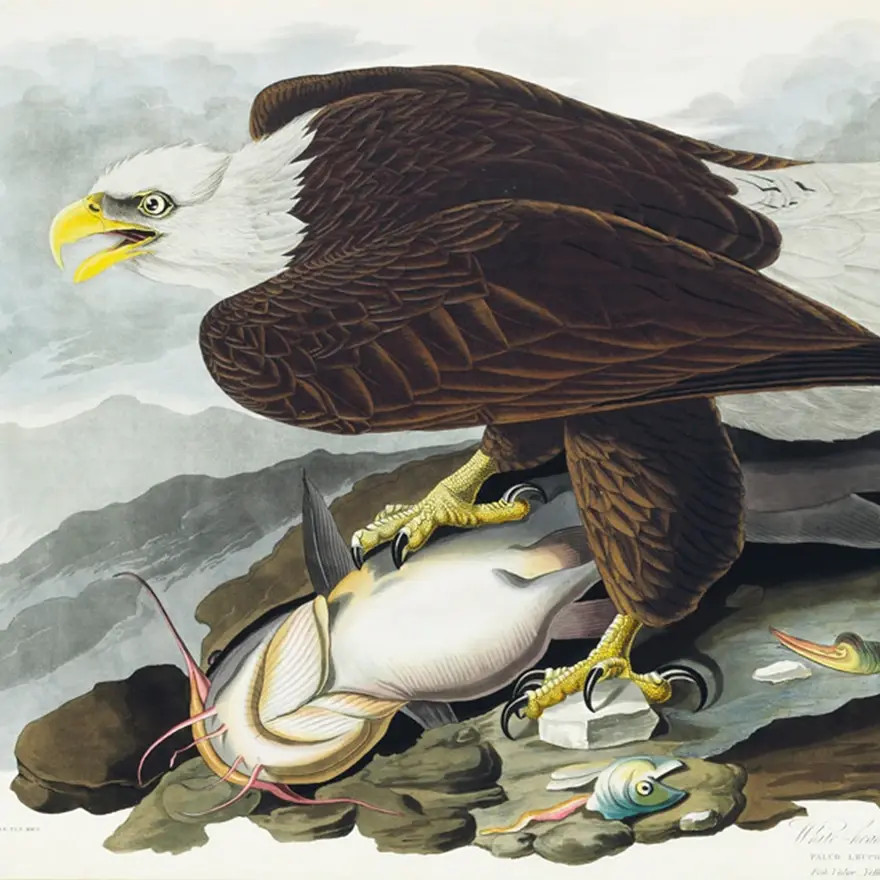It was a spring without voices. On the mornings that had once throbbed with the dawn chorus of robins, catbirds, doves, jays, wrens, and scores of other bird voices there was now no sound; only silence lay over the fields and woods and marsh.
Rachel Carson: Silent Spring (1962), Chapter 1 (A Fable For Tomorrow).
Were bald eagles victims of DDT pollution?

The bald eagle is the national symbol of the United States. In 1963, the harmful chemical DDT brought the eagle population to an all-time low of just 417 pairs! Banning DDT in 1972 helped to save the eagles. By 2021 there were 71,467 pairs!

DDT is a chemical used to kill insects such as mosquitos. It was sprayed on crops and houses to prevent diseases. It got into the water, killing insects, fish, and birds. The book Silent Spring prompted discussions that led to the banning of DDT.
Are you afraid of big bugs?
Some famous “big bug movies” of the 1950’s, such as Tarantula (1954) and Them! (1954), show how scared people were of insects. Sometimes they panicked and used a pesticide called DDT (Dichloro-Diphenyl-Trichloroethane) to protect themselves against the bugs.

Silent Spring - A classic environmental book
Still in print 60 years after it was first published.
600,000 copies sold during the autumn of 1962.
Each copy read by an average of 8 people.
Many more read parts of the book in widely circulated national newspapers
+27 language versions published before 1970.
The trade association of the US chemical industry spent 2.5 million dollars attacking Rachel Carson and her book in the media.
Rachel Carson
Rachel Carson (1907- 1964) was an American biologist who loved nature and wrote about animals, plants, and the environment. Silent Spring made people aware of the dangers of chemicals such as DDT. Her book inspired laws to protect the environment. Earth Day, celebrated every year, was also inspired by Rachel Carson's work, especially Silent Spring.

World Earth Day
Gaylord Nelson, a US senator and governor, was inspired by Rachel Carson's work to found Earth Day in 1970. On April 22 each year, communities, schools, and organizations around the world work together to protect the planet. Join in by planting trees, cleaning up litter, and learning how to care for the environment. Help preserve our planet!

How can you become a steward of nature?
Rachel Carson took her nephew on walks to share with him her sense of wonder about the natural world. In her writing, she encouraged all parents and caregivers to do the same. She said: ”The lasting pleasures of contact with the natural world are not reserved for scientists but are available to anyone who will place himself under the influence of earth, sea and sky and their amazing life.”

Want to know more?
Bibliography
Books and other writings by Rachel Carson (List on the Library of Congress website)
BOOKS ABOUT RACHEL CARSON AND HER BOOKS
Bell, E. S. (2000). The Language of Discovery: The Seascapes of Rachel Carson and Jacques Cousteau. CEA Critic, 63(1), 5–13.https://www.jstor.org/stable/44377486
Gordon, J. E. (2012). Rediscovering a Sense of Wonder: Geoheritage, Geotourism and Cultural Landscape Experiences. Geoheritage, 4(1-2), 65–77. https://doi.org/10.1007/s12371-011-0051-z
Green, L. (2014). Ecology, Race, and the Making of Environmental Publics: A Dialogue with Silent Spring in South Africa. Resilience (Lincoln, Neb.), 1(2). https://doi.org/10.5250/resilience.1.2.002
Jorgensen, K.-A. (2016). Bringing the jellyfish home: environmental consciousness and “sense of wonder” in young children’s encounters with natural landscapes and places. Environmental Education Research, 22(8), 1139–1157. https://doi.org/10.1080/13504622.2015.1068277
Montefiore, J. (2001). “The fact that possesses my imagination”: Rachel Carson, Science and Writing. Women (Oxford, England), 12(1), 44–56. https://doi.org/10.1080/09574040110034110
Nagendra, H. (2020). Rachel Carson: 1907–1964. Resonance, 25(11), 1481–1490. https://doi.org/10.1007/s12045-020-1070-3
Nielsen, L. (2017). Nature’s Allies: Eight Conservationists Who Changed Our World. Washington, DC: Island Press. https://doi.org/10.5822/978-1-61091-797-1
Siiskonen, H. (2002). Silent spring and the Nordic agricultural magazines. The Scandinavian Economic History Review, 50(1), 7–23. https://doi.org/10.1080/03585522.2002.10410799
Smith, M. B. (2001). “Silence, Miss Carson!”: science, gender, and the reception of Silent Spring: Document View. Feminist Studies, 27(3), 733–. https://doi.org/10.2307/3178817
DDT, PESTICIDES AND POLLUTION
Kinkela, D. (2011). DDT and the American century: global health, environmental politics, and the pesticide that changed the world. Chapel Hill: University of North Carolina Press.
Nowlan, L., Adjunct Professor, Allard School of Law, & University of British Columbia. (2018). An international plastics treaty could avert a “Silent Spring” for our seas. The Canadian Press.
Whorton, J. C. (1974). Before silent spring: pesticides and public health in pre-DDT America. Princeton N.J: Princeton University Press.
ENVIRONMENTAL COMMUNICATION AND MEDIA
Bellin, J. D. (2009). Us or Them!: Silent Spring and The “Big Bug” Films of the 1950s. Extrapolation, 50(1), 145–168. https://doi.org/10.3828/extr.2009.50.1.10
Kerslake, L. (2021). Ted Hughes: The Importance of Fostering Creative Writing as Environmental Education. Children’s Literature in Education, 52(4), 478–492. https://doi.org/10.1007/s10583-020-09427-4
Kroll, G. (2001). The “Silent Springs” of Rachel Carson: Mass media and the origins of modern environmentalism. Public Understanding of Science (Bristol, England), 10(4), 403–420. https://doi.org/10.3109/a036878
National Academies of Sciences, E., Division, H. and M., Board, F. and N., Forum, F., & Pray, L. (2016). Food Literacy: How Do Communications and Marketing Impact Consumer Knowledge, Skills, and Behavior? Workshop Summary. Washington, D.C: National Academies Press. https://doi.org/10.17226/21897
Parks, P. (2017). Silent Spring, Loud Legacy: How Elite Media Helped Establish an Environmentalist Icon. Journalism & Mass Communication Quarterly, 94(4), 1215–1238. https://doi.org/10.1177/1077699017696882




















